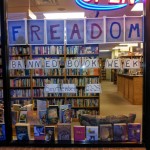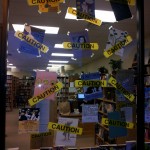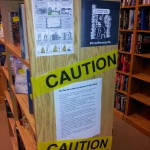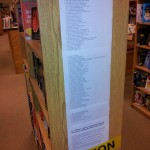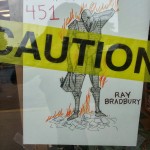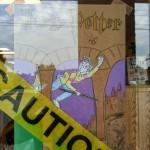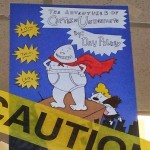That’s right, banned book week. I only found out about this about a month ago, but I wish I had learned about it years ago.
Banned Book Week is an annual event that was first started back in 1982. This year it runs from September 22-28. According to the official Banned Books Week website, since the start of Banned Book Week in ’82 more than 11,300 books have been banned or challenged within schools, libraries, and bookstores, and in 2012 alone around 464 were reported. These numbers don’t include incidents that are unreported, and I can’t even imagine how many of those happen each year.
 I spent a large chunk of the past two weekends at work putting together a display for this week(the pictures may be awful, but it looks fantabulous in person, I swear). I’ve gotten quite a few reactions to it so far.
I spent a large chunk of the past two weekends at work putting together a display for this week(the pictures may be awful, but it looks fantabulous in person, I swear). I’ve gotten quite a few reactions to it so far.
Reactions are, of course, what I’m going for, because I was insanely surprised by many of the books I put on my display. The covers I chose to display on the window were(and I will admit to being a little biased…I hand crafted all of these so if the cover was way too complicated, it wasn’t going on the window): Angus, Thongs, and Full Frontal Snogging, The Adventures of Captain Underpants, Go Ask Alice, Fifty Shades of Grey, The Diary of Anne Frank, Speak, TTYL, Fahrenheit 451, Of Mice and Men, Harry Potter and the Sorcerer’s Stone, and The Perks of Being a Wallflower. According, once again, to the Banned Book Week website, the 10 most challenged books of 2012 (and the reasons they were challenged) are:
- Captain Underpants (series), by Dav Pilkey Reasons:Offensive language, unsuited for age group
- The Absolutely True Diary of a Part-Time Indian, by Sherman Alexie Reasons: Offensive language, racism, sexually explicit, unsuited for age group
- Thirteen Reasons Why, by Jay Asher Reasons: Drugs/alcohol/smoking, sexually explicit, suicide, unsuited for age group
- Fifty Shades of Grey, by E. L. James. Reasons: Offensive language, sexually explicit
- And Tango Makes Three, by Peter Parnell and Justin Richardson. Reasons: Homosexuality, unsuited for age group
- The Kite Runner, by Khaled Hosseini. Reasons: Homosexuality, offensive language, religious viewpoint, sexually explicit
- Looking for Alaska, by John Green. Reasons: Offensive language, sexually explicit, unsuited for age group
- Scary Stories (series), by Alvin Schwartz Reasons: Unsuited for age group, violence
- The Glass Castle, by Jeanette Walls Reasons: Offensive language, sexually explicit
- Beloved, by Toni Morrison Reasons: Sexually explicit, religious viewpoint, violence
My only problem with this list is that it doesn’t tell us where these books were challenged. In my mind, banning Fifty Shades of Grey from a school(elementary, middle, high, take your pick) is different than banning it from a bookstore or public library, but maybe that’s me. I kind of wonder (if there are any teachers/librarians out there reading this) how educators handle this sort of thing. Where do we draw the line between what we think is age appropriate and censorship? Is there a line? Is it still censorship if we say, “you can read it when you’re older”? Also, Captain Underpants, really? Little kids like potty humor–that’s a universal truth(my experience with that this week involved a speaker that was running out of battery and a music clip of a baritone saxophone that I was attempting to play for Kindergartners…lets just say it didn’t sound like a baritone sax in the end and we all ended up with a case of the giggles). Kids like boogers and farting and poop because it’s gross and that makes it funny. I say, let them have their potty humor!
On my dinky little endcaps(I don’t have a lot of space to work with, so I do my best) I stuck the ginormous list of the top 100 banned/challenged books from 200-2009 from the American Library Association, and I encourage you to check it out here. You’ll be surprised, I’m sure, by some of the titles included on the list. Many of them are kids/young adult titles, and many of them are frequently used for required reading at local schools. The little black square on that endcap is actually this picture:
 In March-May(ish) of this year, Chicago area schools attempted to ban Marjane Satrapi’s graphic novel, Persepolis. (A book, might I add, that schools in the Atlanta area often assign for required reading). I can’t quite figure out if all the protesting against this was successful or not, but if you Google “Persepolis” “Banned” and “Chicago” you can see just a little bit of what went on. Looking into the Persepolis case, for me, was a nice dose of reality. I feel as if I never see cases like this at home, but me not seeing them doesn’t mean they don’t happen.
In March-May(ish) of this year, Chicago area schools attempted to ban Marjane Satrapi’s graphic novel, Persepolis. (A book, might I add, that schools in the Atlanta area often assign for required reading). I can’t quite figure out if all the protesting against this was successful or not, but if you Google “Persepolis” “Banned” and “Chicago” you can see just a little bit of what went on. Looking into the Persepolis case, for me, was a nice dose of reality. I feel as if I never see cases like this at home, but me not seeing them doesn’t mean they don’t happen.
If you’re interested in looking further into Banned Book Week, I’d highly recommend checking out a few websites:
- Bannedbooksweek.org and their lovely youtube channel
- American Booksellers Foundation for Free Expression
- Comic Book Legal Defense Fund
- NCAC’s Arts Advocacy Project
- NCAC’s Kid’s Right to Read Project
- American Library Association
- National Council of Teachers of English’s Anti-Censorship Center
- PEN American Center
I’d love your comments, especially if there’s anything on any of the lists that just strikes you as absolutely crazy. I don’t want to say that it’s wrong to agree with the censorship/attempted censorship or disagree. I think the point is freedom of speech. Remember this lovely amendment? (hint, hint, it’s #1)
Congress shall make no law respecting an establishment of religion, or prohibiting the free exercise thereof; or abridging the freedom of speech, or of the press; or the right of the people peaceably to assemble, and to petition the government for a redress of grievances.
So, is anybody going to read dangerously this week?

